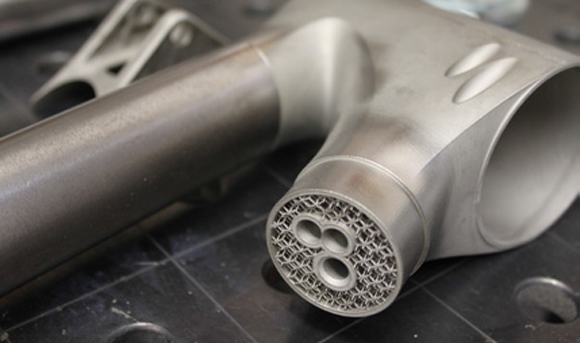Moorehuhn Bike wins first prize in purmundus challenge 2020
November 11, 2020
The winners of the international purmundus challenge 2020, which ran with the theme Geometry and Material in Harmony, have been announced in a prize-giving event at Formnext Connect. First place was awarded to Ralf Holleis of Huhn Cycles for his metal additively manufactured Moorhuhn Bike, which takes advantage of metal Additive Manufacturing to offer stability and light weight.
Second and third places were awarded to polymer AM entries HKK Bionics with the Exomotion Hand One, and Svet Abjo with the Sneaker Zero. The Bolt It, developed by ETH Zürich, Inspire AG and Gressel, took the prize for Simulation Driven Design.
Corinna Ray, head of the purmundus challenge, stated on the challenge entries, “We received more entries than ever before, and the quality has never been higher.” The finalists in this year’s purmundus challenge came from thirteen countries across five continents, with products showcased from China, Germany, the UK, Hong Kong, Israel, Italy, New Zealand, the Netherlands, Nigeria, Austria, Switzerland, Spain, and the United States.
The audience prize remains open for votes until November 22, 2020. The winners of the purmundus challenge will each receive a share of a €30,000 prize fund.
Moorhuhn Fahrradrahmen, by HUHN cycles and Ralf Holleis

The Moorhuhn Bike combines the advantages of super-light titanium tubes with additively manufactured lugs. This makes the joints extremely stiff, explained the designers, as they can be designed according to the forces within a bicycle frame in order to distribute them equally.
The Moorhuhn joints are said to be extremely light and stiff, thanks to an internal lattice structure which supports their very thin walls. The use of AM also makes it possible to produce each frame according to the needs of each individual, so that functions like cable guiding, seat clamps, bearing housings and additional material for welding can be integrated into the design.
“The bicycle industry developed very quickly the last couple years, bikes got lighter and stiffer at the same time,” stated the designers. “Those great achievements were mainly possible with a composite material called carbon fibre, but unfortunately producing this material has a very high carbon footprint. In addition, carbon products have a very short product life-cycle as there is a certain safety risk in using second hand or crashed carbon products.”
“Sadly, there are nearly no ways to recycle this composite material, so most of the time carbon frames end up in landfill or get burned,” they noted. “Metal recycles forever!”
Bolt it, by ETH Zürich, Inspire AG and Gressel

Bolt it was designed through a research and development collaboration by ETH Zürich, Inspire AG and Gressel. The Bolt it concept enables an automated physical and digital post-process chain through automated gripping and handling of the AM part for post-processing.
Using this automated gripping and handling tool, robust machining, with accessibility from five sides, is made possible. A simple torsion removal of the interfaces completes the process.
The two-year project to develop Bolt it was funded by the innosuisse and headed by Julian Ferchow, Research Associate at Inspire AG, ETH Zurich, and Marcel Schlüssel, Head of Technology at Gressel.
















